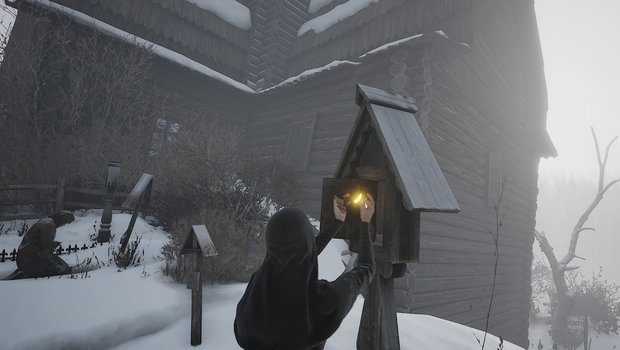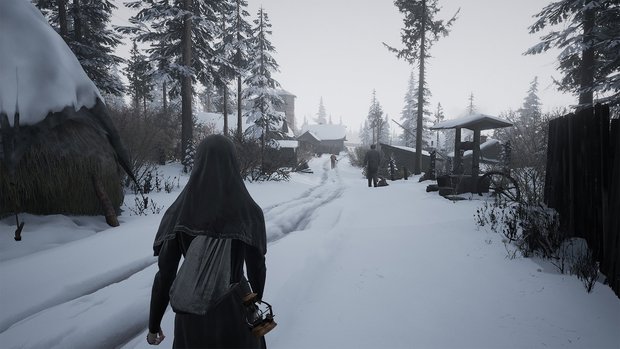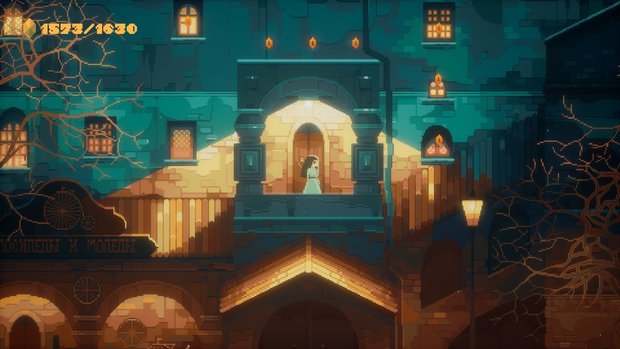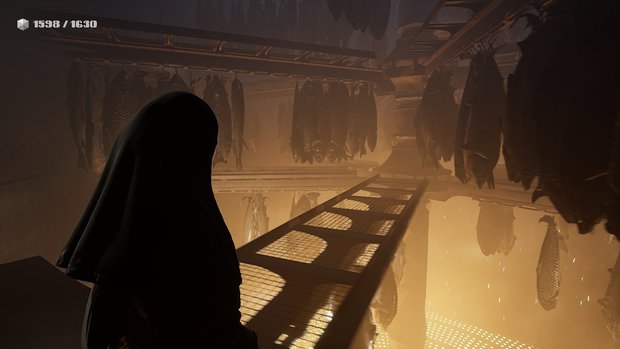INDIKA review

- 0 Comments
Inhabit the role of a nun grappling with her faith in this surreal but highly compelling nineteenth-century drama
Do you sometimes hear a little voice inside your head? One that insults you when you’ve done something stupid? One that seduces you to go for fast food instead of spending an hour in the kitchen preparing something healthy? One that screams at people who irritate you when you’re not assertive enough to utter those sentiments aloud?
Annoying, isn’t it? Your gut feeling tells you these thoughts are valid and give voice to legitimate complaints and desires, but deeper down we know it’s best to ignore the temptation because we don’t want to make matters worse. But where does that voice come from? Is it our conscience, a suppressed part of our personality, or are there really invisible angels and devils riding along on our shoulders, whispering in our ears?
The namesake protagonist of Odd Meter’s INDIKA is a young nun in late nineteenth-century Russia, and she hears a voice too. Her fellow monastics believe something isn’t right and they avoid her and talk behind her back. But things change when Indika is chosen to deliver a letter to a neighboring monastery. During her journey, she meets an injured prisoner of war named Ilya whom she helps escape and tries to nurse back to health. But many dangers block their way, not the least being that voice inside Indika’s head that seems to have only one goal: corrupt her mind and soul.

INDIKA the game is a diverse combination of both first- and third-person exploration, puzzle solving, action sequences, a purely symbolic RPG-like point system, and retro-styled minigames. From the first moments I sat transfixed on my chair watching the story unfold. After my first two-hour playing session, I suddenly noticed the coffee I had poured beforehand had gone completely cold without my ever even taking a sip. That’s how much I was into this game; even after I stopped playing for a bit, my mind kept drifting back to it. It doesn’t end on nearly as strong a note, but what’s in between is a strange but compelling examination of grappling with one’s beliefs in a way that’s intentionally a little uncomfortable, but all the more powerful because of it.
I was initially expecting a fully realistic three-dimensional world as I had seen in the trailer and screenshots. So imagine my surprise when I was confronted with a pixelized menu, followed by a pixel art mini-game of a falling nun. I had to move her sideways to collect a number of gems that got bigger over time, until she was swallowed up by a planet-sized one that finally woke her up in that expected CGI style in the middle of some religious ritual.

Except for some other old-school mini-games that serve as flashbacks – like when Indika races her father around the farm on some prototype motorbikes, as well as a couple of platforming sections spent jumping across window ledges and huge frogs in a pond, and even a Pac-Man-inspired piece – you play the majority of INDIKA from a familiar third-person perspective, freely exploring the world while the camera follows over the protagonist's shoulder. However, this changes to a more immersive first-person viewpoint for the last playable section of the game, which then leads to a disillusioning finale. (I didn’t even realize the game was really over at first, until the credits started rolling.)
The story is set in the middle of a gray, dark winter. The wind is howling all around you. Sheets left out to dry are fluttering in the breeze. Your footsteps crunch in the snow and leave prints behind you. You find yourself in a convent, with other nuns walking around minding their own business. Stop moving and Indika will fidget and start biting her fingernails. This world feels very real, and the excellent English voice actors heighten that impression so much that you quickly forget these characters are supposed to speak Russian. Your journey takes you from the convent through the countryside and forests, into some mines, past a huge millworks and other factories into a neighboring settlement. All locations are desolate and war-torn with dilapidated buildings, featuring lots of brown, gray and black tones, which are in stark contrast with the colorful bright red and yellow flashbacks depicting happier and more carefree times.
The accompanying soundtrack is hard to describe. Just like the graphics often change style, so too does the score change genres. In the convent you’ll hear strange, folklorish off-key music with a modern beat. Further tracks feature 80s-era synthesizer musical sound effects, like when the keyboard strokes imitate a flute. When those pixel art mini-game flashbacks appear, you’ll notice the music has once again changed to a more electronic, Mario-like style. As with its gameplay, INDIKA’s soundtrack seems to be all over the place, and yet it never felt out of place to me.
As you progress, though, the world will start to present some surreal elements. At one point you’ll enter a fish factory where you suddenly pass by a line of oversized specimens; at another you’ll find yourself entering and leaving a furnace room in a continuous loop, only the room gets turned on its side in a kind of impossible M.C. Escher perspective. In yet another location you’ll glimpse a giant animal sleeping on the other side of a fence, its head obscured but looking like a great white wolf. These strange elements aren’t explained, so they leave you as the player wondering about the nature of the game’s reality.

Indika is a young woman around twenty years of age, but she doesn’t wear the more westerly familiar black-and-white nun’s habit. Her gray tunic more closely resembles the burkas of Islamic tradition, though with a wimple exposing her entire face instead of only the eyes. She has a gentle, freckled face with big, wide eyes, as if she’s in constant awe of the world around her. This makes Indika appear fragile, though she is anything but as her journey will soon make apparent. She has a steady voice, and while she’s quite docile within the walls of the convent, once outside and interacting with Ilya the soldier, she exudes a certain strength and the air of someone not to be messed with. She’s the type of main character I prefer in adventure games.
Controlling Indika can be done with a gamepad, but I personally used its keyboard/mouse combo. What struck me immediately in the game’s menu is the possibility to switch between qwerty and azerty keyboards. Even without the added ability to rebind the keys, I was able to maneuver more easily than in other games of this type, with QZSD as the directional buttons, SHIFT to run, and the spacebar to climb – though whenever I quit the game and continued later, I always had to reset the controls since they kept reverting to the other keyboard system.

While guiding Indika through the world, you move the camera with the mouse. A left click activates hotspots indicated by a circle shape; a right click starts Indika praying, but more on that later. During the first scenes in the convent, you are given a couple of menial tasks. The last one especially is quite tedious: you need to fill a barrel with water, but it takes five trips to the well. It’s simply explained as part of the hassle of convent life. The direction of your destinations for these tasks is indicated on-screen by a diamond shape, but without an overview map it’s confusing where exactly you need to go. I walked up to the wrong building several times. Once Indika goes on her big courier mission, however, that diamond shape no longer turns up, but it’s not needed to follow Ilya around.
At the start of INDIKA, it seems that the game is being narrated by a John Hurt-like storyteller – quite the talented voice actor, I might add – until you notice Indika replying to him. That’s when it becomes clear he’s actually that little voice inside her head, commenting on her life and experiences. But not only that – at key moments throughout the game, Indika will succumb to temptation, like when she reads the sealed letter she’s supposed to deliver, and the voice will suddenly start shouting a long, looping monologue condemning every hardship in Indika’s life while the ground beneath her feet suddenly breaks open as if hell is bursting out, showering everything with a blood-red, end-of-times glow. All that’s missing are the flames. Indika’s entire immediate environment will change, but when she prays, the world returns to normal. Using both “versions” of the world to her advantage, she can climb her way past obstacles, creating new pathways when rocks are pushed upward and bridges are created.
Sometimes when your path is blocked in the “normal” world, Indika needs to use machinery to open up pathways, like cranes and forklifts. These take quite some spatial insight, and I often wished I could have zoomed out a bit to get a full grasp on the surroundings and to better figure out what it was exactly that I had to do, and where exactly to do it. Nevertheless, this great variety in gameplay is one of INDIKA’s strong suits. You certainly can’t say it’s a boring game, especially when you’re suddenly confronted with a dangerous chase sequence.
Yes, you can die in this game, both by being caught by an enemy – like a pursuing soldier or a big scary dog hunting you down – and by plummeting to your death by jumping off a ledge that’s too high. But have no fear, as you’ll respawn at the moment right before you made the wrong move. The main story also confronts you with some disturbing and violent cutscenes, though most is left to the imagination. It’s too bad that the game doesn’t allow manual saves and instead goes for a checkpoint system, because when you quit and continue later, you may have to watch the same unskippable cutscene again (and they can get quite long).
The game’s chapters are divided by quotes from scripture, but sometimes you get a message about the “futile” point system. During your travels, you can find hidden religious icons, or votive candles you can light, for which you get points. In the top left corner you always see your current total, and the amount you need to level up. The more points you collect, the more “abilities” you can unlock, with notions such as SHAME, GUILT or REPENTANCE, leading either to extra points or multipliers. The existence of these points is pure symbolism, however, with no tangible effect on the gameplay or story, though they do encourage exploration and provide a fun extra goal to aim for.
Final Verdict
Despite an abrupt ending that kept me wanting more closure, INDIKA’s journey, with its different varieties of gameplay, gorgeous if drearily realistic environments while exploring and playful retro pixel art for the mini-game flashbacks, captivated me from beginning to the credit roll. It’s a story of right and wrong, and realizing that doing what’s expected of you through the doctrine of religion doesn’t safeguard you from evil. It raises the question of whether you should resort to turning “evil” yourself then, and whether all acts can even be categorized that way to begin with when looking at basic needs and survival. Are morals universal or merely a human construct? Is religion an absolute truth or a manipulative tool? While I was expecting quite a controversial game, I was happy to find it isn’t all that in-your-face. It certainly offers food for thought if you like to philosophize, or you can simply play the game, experience the (sometimes disturbing) five-hour story and ignore all the symbolism. I for one will be praying that the developers make more games like this!
Hot take
INDIKA is an eclectic mix of graphic styles and gameplay about a young nineteenth-century Russian nun that will keep you glued to your seat with its challenging but mature reflection on faith and human morality.
Pros
- Engrossing storyline
- Great variety of gameplay
- Impressive “storyteller” voice actor
- Supports alternate keyboard control schemes
Cons
- Spatial puzzles can get confusing
- No manual saves and cutscenes can’t be skipped after reloading a chapter
- A rather abrupt and unfulfilling ending
Johnny played INDIKA on PC using a review code provided by the game's publisher.











0 Comments
Want to join the discussion? Leave a comment as guest, sign in or register in our forums.
Leave a comment